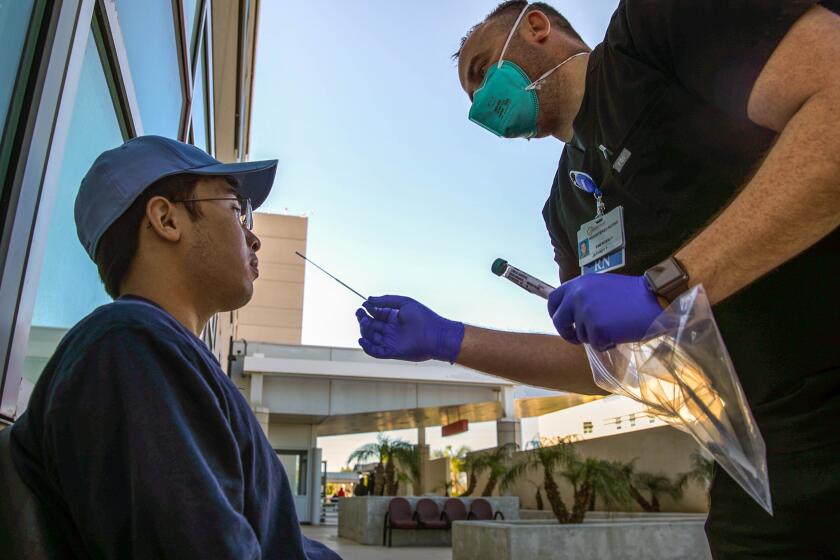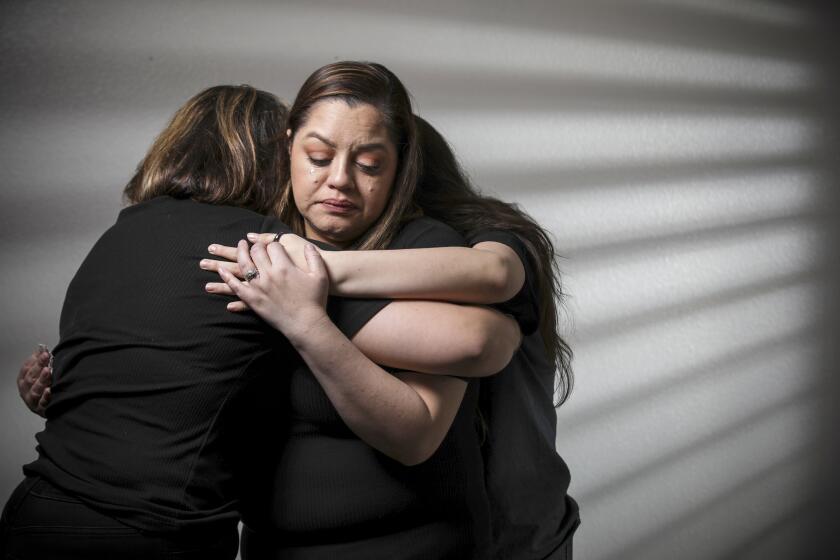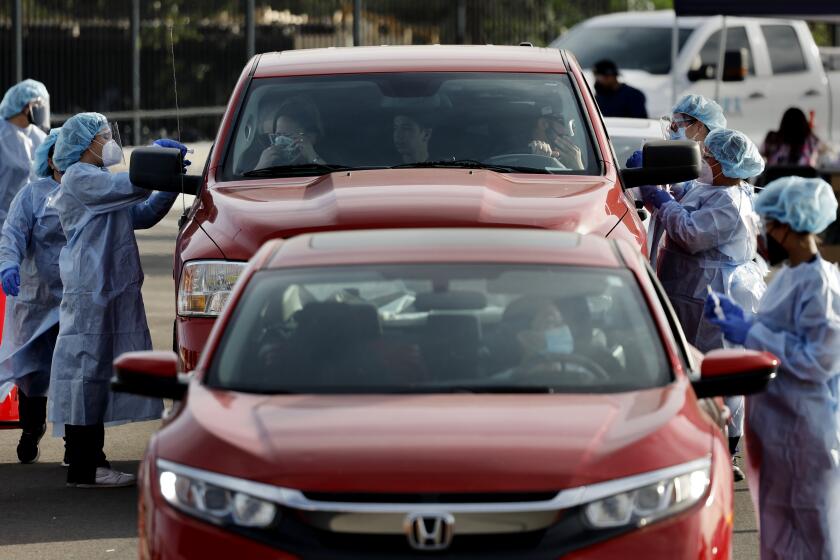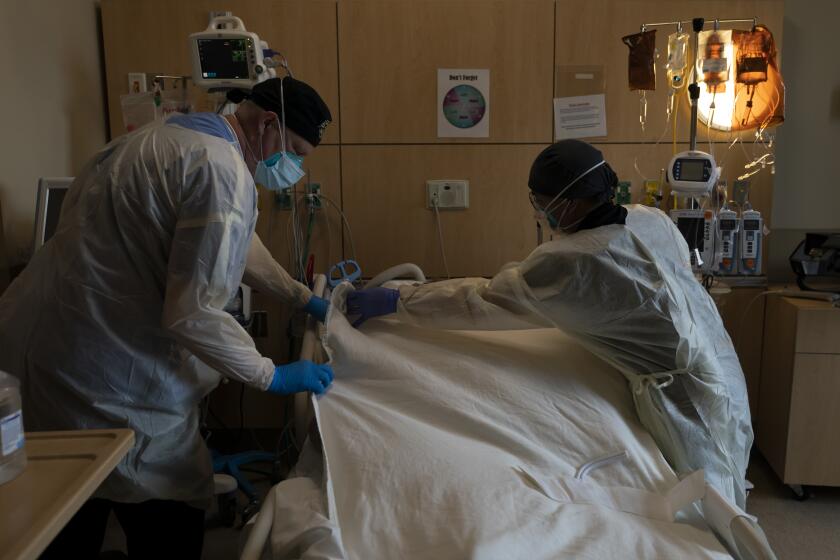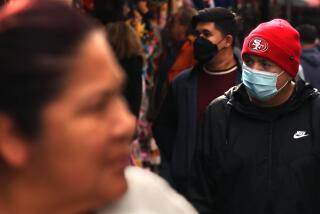California surpasses 7 million coronavirus cases, adding 1 million in one week
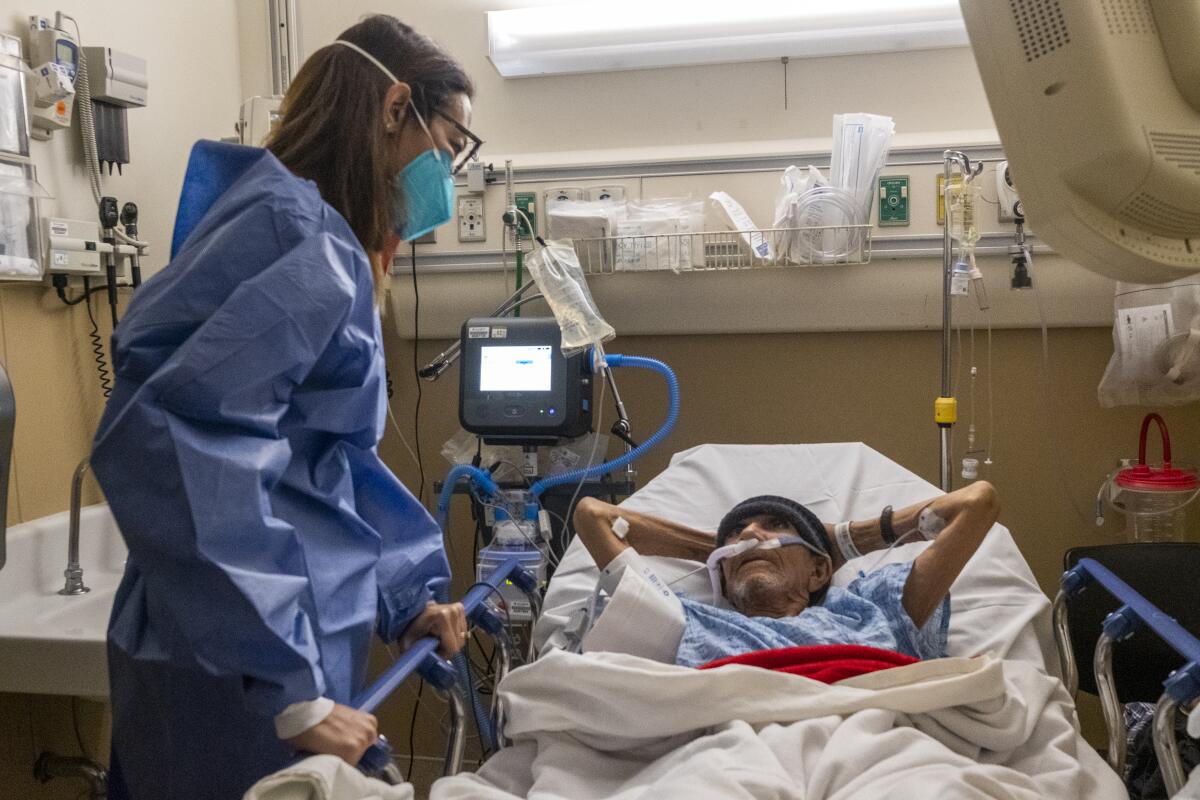
- Share via
California has recorded more than 7 million coronavirus cases after its fastest accumulation of reported infections in the history of the pandemic.
The unprecedented count, recorded in California’s databases late Monday, comes one week after the state tallied its 6 millionth coronavirus case.
Even during last winter’s disastrous wave, new infections increased more slowly. It took a little over three weeks for California to get from 2 million cumulative coronavirus case to 3 million.
The stunning speed of new infections is a testament to the Omicron variant’s transmissability; Omicron is believed to be two to four times more contagious than the Delta variant, which in turn was more infectious than earlier strains that pummeled California last winter.
“Let’s not fool ourselves by not recognizing the danger presented by the Omicron variant, which is capable of spreading with lightning speed and causing serious illness among our most vulnerable residents,” Los Angeles County Public Health Director Barbara Ferrer said.
L.A. County logged 31,576 new coronavirus cases on Monday, as well as 27 related deaths.
California’s daily COVID-19 death rate has also risen dramatically. For the most recent seven-day period, the state was recording 106 deaths a day; that’s roughly double the last week of 2021, when 55 deaths a day were tallied.
At its worst, California’s COVID-19 death rate over a weekly period was 545 deaths a day, reached during late January 2021.
In Los Angeles County, the COVID-19 death rate has doubled in the last week. For the seven-day period that ended Tuesday, the county was averaging 45 deaths a day; in the prior week, the average was 20 deaths a day.
L.A. County’s peak death rate last year was about 240 deaths a day.
Even before his father’s death, the teen had penned a school paper on the pain of life during the pandemic.
Although some health officials have said the recent COVID-19 deaths are probably the result of the Delta variant, the L.A. County Department of Public Health in recent days has noted that many fatalities have occurred among people who were infected when Omicron was clearly the dominant variant.
On Saturday, Los Angeles public health officials said that “the majority of deaths reported this week are associated with individuals who became infected after Dec. 20, when Omicron was circulating widely,” suggesting the variant may have a bigger role in COVID-19 deaths than initially believed.
The dramatic surge in infections is contributing to strained hospitals across swaths of California, many of which have said they’ve been forced to cancel scheduled surgeries amid crushing demand in emergency rooms.
“While vaccines and boosters provide powerful protection, those who are older, have serious health conditions or are immunocompromised remain at higher risk,” Ferrer said. “We still don’t know the longer-term consequences from Omicron infections, including the development of long COVID or MIS-C among children.”
The high rate of infections has also contributed to even scarcer staffing in hospitals. California’s state epidemiologist, Dr. Erica Pan, said last week that “we are seeing near-crisis levels” of emergency room overcrowding in certain areas.
With fewer hospital workers, it’s harder to admit patients from the ER, which then keeps ambulances waiting for long periods to drop off patients, resulting in a worsening of 911 response times to new callers, Pan said.
Scientists warn that Omicron’s whirlwind spread across the globe practically ensures it won’t be the last worrisome coronavirus variant.
The number of patients admitted to hospitals for all reasons last week was nearing the state’s pandemic record. As of the middle of last week, there were 52,400 patients in California’s hospitals, just shy of the record 53,000 admitted during the worst of last winter’s surge, when many hospitals were overwhelmed.
By Monday, there were 2,311 coronavirus-positive patients in California’s intensive care units, a number that exceeds the height of the summer Delta surge, when there were 2,128. Still, the latest number remains well below the state’s record of 4,868 recorded during last winter’s peak, a time when few people were immunized.
There were 14,639 coronavirus-positive patients in California’s hospitals on Monday, more than double the number on New Year’s Day, when there were 6,237. The latest number exceeds the height of California’s summer surge, when 8,353 coronavirus-positive patients were hospitalized, but is far below the peak experienced last winter, when the number reached 21,938.
However, coronavirus-related hospital demand has already reached record levels in some areas. In Sacramento County, 570 coronavirus-positive patients were hospitalized Monday, above the previous peak of 518 seen last winter.
The same is true in Marin County, where Monday’s census of 44 patients topped the peak of 39 recorded last January. And with 256 coronavirus-positive patients, San Francisco is three shy of matching its all-time high.
“With the rise of the hospitalizations due to COVID-19, many of our hospitals are reaching capacity in delivering emergency care to patients,” said Dr. Clayton Chau, Orange County’s health officer and director of the county Health Care Agency.
Some parts of the globe that saw Omicron explode are now seeing the wave recede or flatten. California is expected to follow soon.
But in Northern California, some officials have expressed hope that the winter wave may soon crest.
In Santa Clara County, Northern California’s most populous county, coronavirus levels in wastewater started declining about 1½ weeks ago. Officials expect the dip will presage a sustained decline in coronavirus cases.
And the exponential growth in California’s case rate also appears to be leveling off, although it probably will take a few days — following any reporting backlog from the Martin Luther King Jr. holiday weekend — to be sure.
According to data released Tuesday that reflect numbers through Monday, California was averaging 104,000 cases a day for the most recent seven-day period, slightly above the prior week’s rate of 101,000; the week before, the state was reporting 55,000 cases a day. California’s case rate reached a high of more than 115,000 cases a day in the middle of last week, and fluctuated between 114,000 and 115,000 for a few days.
Some of the state’s most populous regions may be starting to see a leveling in case rates. Southern California recorded 69,000 new cases a day over the most recent seven-day period, about flat compared with the 71,000 from a week earlier. The week before, the region tallied 39,000 cases a day.
L.A. County posted a record number of coronavirus cases last week, nearly 42,000 a day. But based on numbers released since then, the county is now averaging about 38,000 cases a day.
The fast-moving Omicron variant may cause less severe disease on average, yet COVID-19 deaths in the U.S. are climbing.
The Bay Area is now averaging about 19,000 coronavirus cases a day, a rate that has fluctuated between 18,000 and 22,000 for roughly the last week. The Greater Sacramento area recorded about 5,500 cases a day for the most recent weekly period. The capital region has been fluctuating between 5,000 and 6,000 cases recently.
In the Greater San Joaquin Valley, a region that has generally lagged behind trends in Southern California and the Bay Area, cases are still going up. The area tallied 9,300 cases a day over the last week, higher than the 6,500 cases a day for the prior week; the week before that, the region recorded 2,900 cases a day.
In rural Northern California, about 750 cases a day were reported in the last week, up from about 680 the week before, and more than double the roughly 300 cases a day the sparsely populated region reported two weeks ago.
The rate at which California’s coronavirus tests are coming back positive has started to decline. For the seven-day period that ended Jan. 10, California hit a record positive test rate of 23.1%. Since then, the rate fell to 21.5% for the seven-day period that ended Saturday. The rate is still very high; by comparison, in early December, it was around 2%.
A similar trend is holding for Los Angeles County. L.A. County’s seven-day positive result rate may have peaked at 22.7% for the seven-day period that ended Jan. 3; for the weekly period that ended Tuesday, the positivity rate was 16.3%. In the first week of December, it was around 1%.
Meanwhile, some states on the East Coast that were hit earlier by the Omicron wave have started to see a sustained decline in cases. New York recorded a peak of about 85,000 new coronavirus cases a day for the seven-day period that ended Jan. 9; that figure has fallen to 49,000 a day for the seven-day period that ended Monday.
More to Read
Sign up for Essential California
The most important California stories and recommendations in your inbox every morning.
You may occasionally receive promotional content from the Los Angeles Times.
